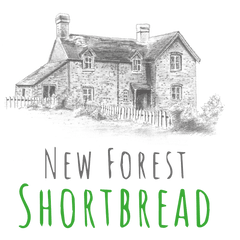"From A New Forest Inclosure”
Just the other day, we had a lovely and informative morning, Guy Roughton and his sister Wendy Jackson paid us a visit. ‘So what?’, I bet your thinking, or ‘who the devil are Guy Roughton and Wendy Jackson?’ Well, some of you will surely know, for these two people spent some of their childhood in this very house, here in the Inclosure, and we were looking forward to hearing all about their lives back in the early 1960’s.
They arrived bearing a much worn photograph album which contained many cherished snaps of children, ponies, pets and gigs, traps and caravans of every description. On opening the book I was surprised to note that it had Burley Rails Cottage inscribed in the fly leaf. Now most Ordnance Survey maps note this property as Woolfield Cottage, which I guess was the original name, and no doubt given because of its location on Woolfield Hill. Prior to reading this, I had assumed that the name was changed at the time of disposal, by the Forestry Commission, in 1970 but, clearly, it was known as Burley Rails in 1961. So the mystery of the name change continues.
I entered into discussion on this subject with my visitors who told me that they were brought up to believe that they lived on Wolf Hill – the site where the last surviving wolf in the New Forest was, supposedly, shot. I had heard of this Forest tale before and have often heard local people refer to my home as Wolf Cottage. However, an encounter, a few years ago, with a strolling historian provided a differing opinion. He claimed that the cottage was sighted on the ‘Woolfield’ where sheep drovers travelling from Lymington to Swindon (or perhaps the other way round!) rested their flocks overnight. Certainly the spelling gives credence to the latter idea but there is a little more intrigue in the former – don’t you agree?
Anyway, back to my visitors. Together, we looked through the album and marvelled at just how much the cottage (and some of you) have changed in fifty-odd years. When the Roughtons were in residence, mains water, electricity and drainage were not. Initially and until a well could be excavated, Mrs Roughton would drive, on a daily basis, in a pony and trap, to the Queens Head in the village and collect water from an outside tap! Lighting was provided by gas lamps with the luxury of an oil lamp in the sitting room and the out-door, earth-closet privy was eventually replaced by an indoor ‘Elsan’ – very posh! Heating and cooking with a wood-fired Aga completed the mod cons of the property which they rented from the Forestry Commission for the princely sum of 7s 6d (37.5p!). The family were self-sufficient and kept a Jersey house-cow, for milk, along with chickens, ducks, two pigs, two ponies, cats and a collie dog.
The two siblings wandered around the house and explained what had been where, in their occupancy, and then we went for a look outside. They pointed out the location of the pig sty and the stables. Their father was an avid collector of all forms of horse drawn vehicles and did, for some time, take children out on day trips which cost £1.00 per child and included a picnic lunch and a barbequed tea.
They were both surprised to see that the double gates to the side of the property were still there, or should I say replacements for the set which were pretty rotten when I arrived here twenty-one years ago. These gates lead to a grass ride which, in turn, leads down to the river where they built dams in the summer to create swimming holes. What fun! Can you imagine children doing that today?
Must go now, there’s someone else at the gate!
Ian Thew












Leave a comment